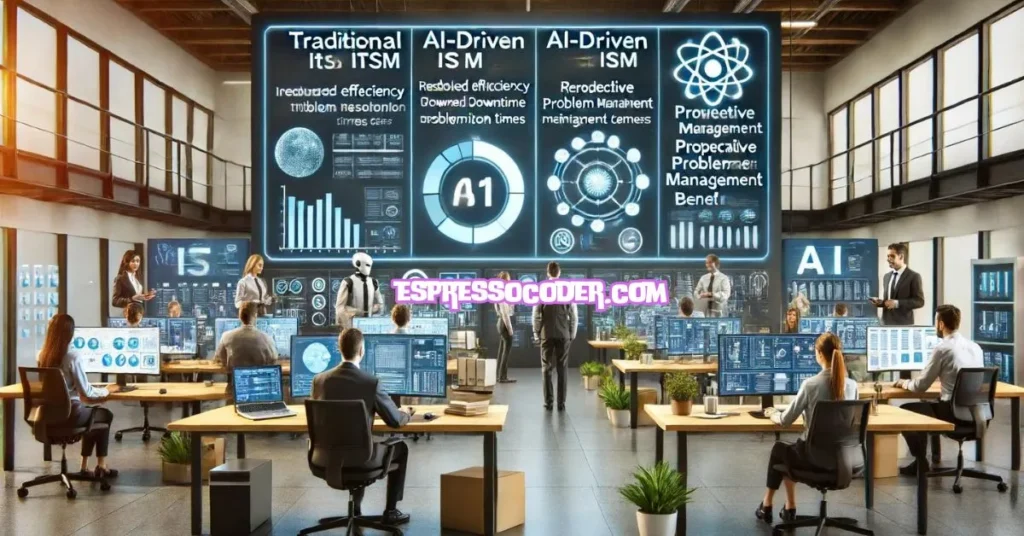The integration of Artificial Intelligence (AI) in the delivery of IT services is revolutionizing the industry. From enhancing efficiency to improving user experiences, AI offers numerous benefits that are transforming how IT services are managed and delivered. This paper explores the various advantages of utilizing AI in IT service management (ITSM), supported by relevant examples and data.
Contents
Enhanced Efficiency and Productivity
AI-driven automation is significantly enhancing efficiency and productivity in IT services. Routine tasks such as ticket management, system monitoring, and incident resolution can be automated, freeing up IT professionals to focus on more strategic activities.
Comparison of Traditional vs. AI-Driven IT Service Management
| Feature | Traditional ITSM | AI-Driven ITSM |
| Ticket Resolution Time | 30-60 minutes | 5-10 minutes |
| Incident Detection | Manual | Automated |
| Resource Allocation | Static | Dynamic |
| User Satisfaction | Moderate | High |
As shown in Table, AI-driven ITSM significantly reduces ticket resolution time and automates incident detection, leading to higher user satisfaction.
Proactive Problem Management
AI systems can predict and prevent potential issues before they impact the user, shifting the focus from reactive to proactive problem management. Predictive analytics and machine learning algorithms analyze historical data to identify patterns that indicate potential failures or security breaches.
Benefits of Proactive Problem Management
| Metric | Without AI | With AI |
| Downtime | Higher | Lower |
| Maintenance Costs | Higher | Lower |
| Incident Frequency | Higher | Lower |
| Customer Complaints | Higher | Lower |
Table highlights the reduction in downtime, maintenance costs, and incident frequency when AI is used for proactive problem management.
Improved Decision-Making
AI enhances decision-making processes by providing real-time insights and data-driven recommendations. IT managers can leverage AI to make informed decisions on capacity planning, resource allocation, and system upgrades.
Key AI Tools for Decision-Making
- Predictive Analytics: Analyzes trends and patterns to forecast future events.
- Natural Language Processing (NLP): Understands and interprets human language for better communication.
- Machine Learning: Continuously learns from data to improve accuracy over time.
Enhanced User Experience
AI enhances the user experience by providing personalized and prompt support. Chatbots and virtual assistants, powered by NLP, can handle common queries and issues, ensuring users receive immediate assistance.
Benefits of AI-Powered User Support
- 24/7 Availability: Users can get help anytime, reducing wait times.
- Personalization: AI systems learn user preferences and tailor responses accordingly.
- Consistency: Provides uniform support, ensuring all users receive the same level of service.
Cost Reduction
Implementing AI in IT services can lead to significant cost reductions. By automating repetitive tasks and improving resource utilization, organizations can save on labor and operational costs.
Cost Savings with AI Implementation
| Expense Category | Traditional ITSM | AI-Driven ITSM |
| Labor Costs | High | Low |
| Operational Costs | High | Low |
| Training Costs | Moderate | Low |
| Total Savings | – | 30-50% |
Table demonstrates the potential cost savings that an organization can achieve by adopting AI in IT service management.
Enhanced Security
AI enhances IT security by continuously monitoring for unusual activities and potential threats. Machine learning algorithms can detect anomalies and trigger alerts in real-time, enabling swift response to security incidents.
Key Security Features of AI
- Anomaly Detection: Identifies unusual patterns that may indicate security breaches.
- Threat Intelligence: Continuously updates with the latest threat information to provide proactive defense.
- Automated Response: Quickly contains and mitigates security threats without human intervention.
Scalability
AI enables IT services to scale efficiently. As organizations grow, AI systems can handle increased workloads without a proportional increase in resources. This scalability ensures that IT services remain effective and efficient even during rapid expansion.
Integration with Existing Systems
AI can seamlessly integrate with existing ITSM systems, enhancing their capabilities without requiring a complete overhaul. This compatibility ensures that organizations can leverage AI’s benefits without significant disruptions to their operations.
Strategies for Successful Integration
- Incremental Implementation: Start with small, manageable AI projects.
- Training and Support: Provide adequate training for staff to ensure smooth adoption.
- Continuous Evaluation: Regularly assess AI performance and make necessary adjustments.
Conclusion
The integration of AI in the delivery of IT services offers substantial benefits, including enhanced efficiency, proactive problem management, improved decision-making, and cost reduction. AI-driven solutions not only improve the user experience but also ensure robust security and scalability. For any ITSM company, leveraging AI can lead to significant competitive advantages and operational improvements.
FAQ
What is ITSM?
IT Service Management (ITSM) refers to the activities involved in designing, delivering, managing, and supporting IT services.
How does AI improve IT service delivery?
AI improves IT service delivery by automating routine tasks, providing real-time insights, enhancing security, and offering personalized support.
What are the cost implications of adopting AI in IT services?
While there may be initial investment costs, AI can significantly reduce labor, operational, and maintenance costs in the long run.
Can AI replace IT professionals?
AI is not intended to replace IT professionals but to augment their capabilities by taking over repetitive tasks and providing data-driven insights.
How can an organization start integrating AI into its IT services?
Organizations can start by identifying specific areas that would benefit from AI, implementing pilot projects, providing necessary training, and continuously evaluating the results for improvement.

